#Jewish tales of the supernatural
Text
My Favorite Books I Read in 2022
I read a TON of books in 2022- roughly 62, (and 54 separate graphic novels/manga series, but we’ll cover that in another post). You can see them all here- the print books start with Hench.
This was thanks to how I started listening to audiobooks while doing chores/working out in addition to reading, and some downtime at the office where I checked out low effort reads. So I thought it would be fun to just give some very quick overviews of the best books I read this year.
First up is:

This is How You Lose the Time War by Max Gladstone and Amal El-Mohtar
Deliciously lyrical and lovely, this novella tells the story of two dangerous women who are rivals on the opposite side of a war fought through time-travel- they taunt each other through letters and ever-so-slowly fall in love. I failed to finish this when I attempted it a couple years ago, I wasn’t in the best place and while I knew the writing was great, I had a hard time processing all the information. I’m really glad I gave it another shot with the audiobook- the narration is wonderful and drew me right in. I would to each letter and then read it in print, tasting each word again like a drop of sweet, dark syrup. It’s got a wonderful fairy-tale element despite being a sci-fi and the colorful picture it paints of time-travel and the ever shifting identities and forms the characters take on is worth getting lost in.
Spinning Silver by Naomi Novik
I listened to this on audiobook, and it was a great experience. I still have an image in my head of huddling in bed late at night, the narration like a dark, icy wind rattling the windowpane, yet each sentence cradled me and made me feel even cozier under the covers. Based on Polish folklore, the narrative follows a girl who tires of how the villagers spurn and scorn her family for being Jewish moneylenders, so she decides to take matters into her own hands- but her business saavy and talent for multiplying silver catches the attention of some fearful supernatural beings who want to cut a deal. Her story intersects with two other women- one a princess on the run from a demon, one a girl with a family in debt and a cruel father. It’s a sharp and biting fairytale with a lush sense of a setting. I had a few matter-of-my-own-taste quibbles with the ending, but it was a wonderful winter journey.
One Last Stop and I Kissed Shara Wheeler by Casey McQuiston
One Last Stop follows a college girl new to NYC who gets in a romance with a woman who seems to be mysteriously bound to a the subway- and bound to the wrong decade when she should be in the 1970′s! This is a full on mega-cheesy, tooth achingly sweet romance, but for once it’s kinda laser-targets at my gay, awkward self, so I actually really enjoyed it. I wasn’t even bored by the sex scenes and liked reading them, which is unusual for me.
I didn’t enjoy I Kissed Shara Wheeler quite as much, but it’s still worth a mention. The protagonist is a gay girl trying to adjust to existing in a Bible-Belt school, who receives a kiss and a mysterious letter from the supposedly perfect fundie popular girl Shara Wheeler- right before Shara disappears. It’s a YA, and it does a good job capturing what it’s like to be a teen-in-denial of how much they love mess when it comes to love interests, and touches on some of the struggles being queer in the conservative area, while striking down the idea everyone should just move to New York for salvation.
The Deep by Rivers Solomon
This novella tales the tale of Yetu, a member of an undersea race descended from pregnant African women who were thrown off slave ships. She is tasked with carrying the memories and pain of all the generations of her people. It’s an affecting and gut-twisting examination of generational trauma and how one copes with it- is it possible to carry all that agony, or is it best to forget? The narration was a bit dry at times, but it’s a story that stays with you.
I'm Glad My Mom Died by Jeanette McCurdy
Heartbreaking but at times darkly funny, McCurdy’s memoir about her relationship with her abusive mother and struggles with child stardom is worth all the hype, in my opinion. The writing is punchy and the story is told in short vignettes that make for an addicting read/listen. McCurdy does a great job communicating the degrading horror of both familial abuse and exploitative studios, while sardonically highlighting the absurdity the abuse thrives.

Otherside Picnic Vol 7: Funeral of the Moon by Iori Miyazawa
Otherside Picnic truly has my heart. The stories themes of healing from abuse and trauma come to a triumphant crescendo in this volume where Sorawo decides to deal with the Satsuki problem once and for all. It actually inspired me to write a whole article about the themes surrounding trauma, abuse and recovery in this series and how wonderfully they’re handled, which should hopefully be out it couple months!
Nona the Ninth by Tamsyn Muir
Cows. Free Mustache Rides. Barbie. Nona is impossible to spoil. I got even more hype for The Locked Tomb series after re-experiencing the first two installments in the excellent audio books narrated by Moira Quirk, and Tamsyn Muir cracked my brain open all over again. We get to see a little bit more of what life is like outside the Nine Houses in this one. I found it a little more plodding than the previous two, but it’s still a great installment of my current favorite book series. I’m probably going to listen to the audiobook version soon, which considering I only read it a few months ago, that tells you just how much I enjoyed it.
Loveless by Alice Oseman
A YA following a university girl on a journey to realizing she’s aromantic-asexual. Her fears and feelings of alienation drive her to make some bad choices and risk losing what’s really important. This book almost felt too painfully real- I’m not aromantic, but I came to terms with being asexual in college, and struggled in a similar way. I still struggle sometimes. But while the relatability was almost painful, I felt a deep kinship with this book, and these messy, silly teens and their messy, beautiful friendships. Asexuality is still so rarely talked about and represented that I’m really glad this is out there.
The Honeys by Ryan La Sala
A haunting YA horror, the story follows Mars, a genderfluid kid who was chased out of a fancy rich-kid summer camp that enforces a strict gender binary. His sister remained at the camp and hung out with a group of beautiful, popular girls nicknamed the Honeys. After she ends up dead under suspicious circumstances, Mars goes back to camp to find the truth, but now he himself is hunted. With spooky and visceral prose, some pointed and well deployed social commentary, and an A+ atmosphere, this was a great October read.
The Seven Husbands of Evelyn Hugo by Taylor Jenkins Reid
I’d been stinging from disappointment from some books I’d been anticipating but found myself trudging through at times, so this page-turner was a breath of fresh air. The book is about a woman interviewing a movie star from the golden age of cinema known as Evelyn Hugo, only to find that her life was full of secrets and her seven husbands are far from the most interesting relationship in her life. The prose might be too simple for some, but I think it made sense in the context of a woman narrating her life to someone, and it made it very accessible. I knew the main 'twist' of the story, but there were lots more twists it pulled off well. I appreciate that Evelyn was so flawed, and that the book wasn't afraid to let the reader wrestle with a lot of the bad things she did while still showing areas where she deserved sympathy. There were a lot of parts I wish the book could have gone more in depth with (though in the context of a woman telling her life story, it did make sense she didn't in certain areas) and that the viewpoint character was a little more developed, but overall I really enjoyed this as a quick read.
Norse Mythology By Neil Gaiman
A great primer on Norse myth- there were only a couple of these I knew in detail, with a few other I knew about vaguely, and I found it to be a really entertaining and accessible read. Probably not as useful for a Norse Myth know-it-all, but it did a good job piquing my interest.
Bonus reads- these weren’t quite five stars, but were interesting enough to be worth mentioning!
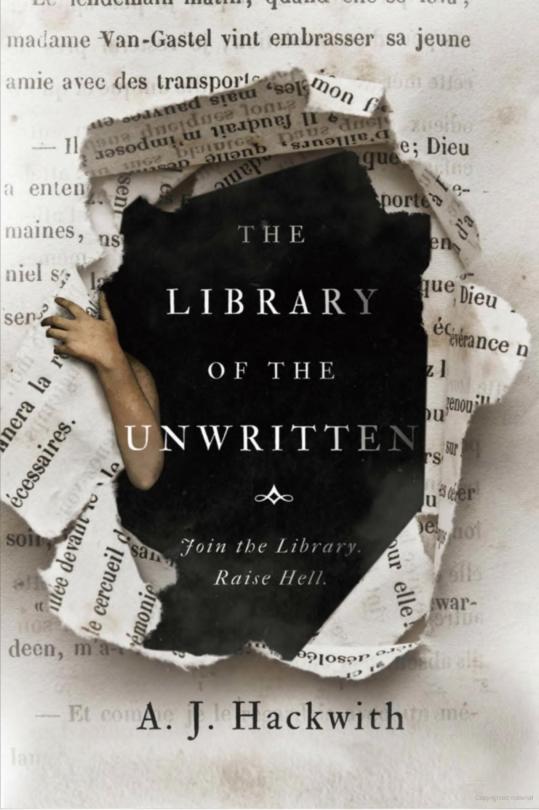
Library of the Unwritten by A.J. Hackwith
In Hell, there’s a library for unfinished stories. The problem is, the characters sometime escape their stories and cause mayhem. It’s up to Hell’s librarian to wrangle them. This had a killer premise and likeable characters, but I found the narrative a little detached and thought it tried to do a little too much at once. Still definitely worth checking out for fans of stories about stories.
Carmilla by J. Sheridan Le Fanu
I read Dracula this year, but I found the classic lesbian vampire story held together a bit better overall, even if the ending was really anticlimactic. I loved the titular vampire. You can check out my reactions here!
T.J. Powar Has Something to Prove by Jesmeen Kaur Deo
This was a really sweet little YA story about an Indian-American girl dealing with the stigma around her body hair. I did find the debate parts a bit dull though, despite the fact I was in debate in high school
Thistlefoot by GennaRose Nethercott
A story steeped in Jewish folklore where two siblings inherit a Baba Yaga house. I found the middle a bit of a slog (and there were a few characters who didn’t have a real reason to be there) but the ending came together really well.
Hench by Natalie Zina Walschots
A temp worker in the henchmen-for-supervillains business gets injured by a hero, and nursing a grudge, uses her statistics know how to destroy the superheroes in creative ways. Her talent catches the eye of the premiere villain, and she gets in deep. It was a really creative concept and biting look at the gig economy and the world of celebrity, and I enjoyed a lot of it! While the heroes are assholes, the stuff the villains do to them (and especially their families) can get pretty uncomfortable, which I found interesting in a morally-grey way but I did wonder about the weird fixation the book had with kidnapping children. I know it’s a go-to for supervillains, but it’s still weirdly overused. And while I don’t mind body horror, the ending was so fixated on it that I actually had to flip ahead to get through it, it was so repetitive and a little bizarre. Still, it stuck in my head and I’m down for a sequel.
---
It was a good year in books and I’m looking forward to the next one!
#year in books#my reviews#books#otherside picnic#this is how you lose the time war#the locked tomb#spinning silver#queer lit#recs#thistlefoot#hench
104 notes
·
View notes
Text
tagged by @lovlettres to post some of the books i want to read this year! i love doing these >:)





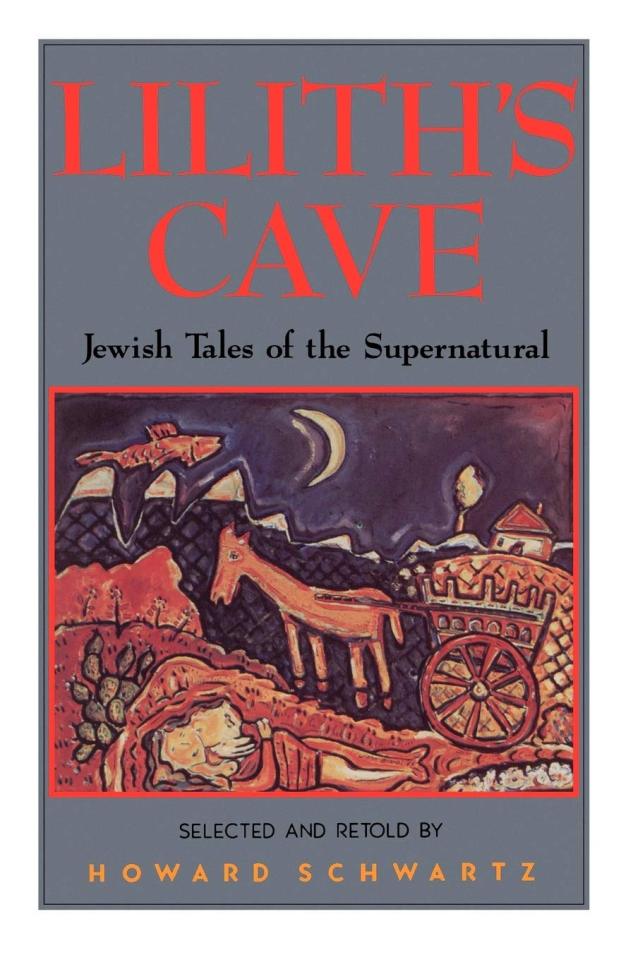



Umberto Eco, The Name of the Rose
G. Aloysius, Nationalism Without a Nation in India
Johnhenry Gonzalez, Maroon Nation: A History of Revolutionary Haiti
Constructing Medieval Sexuality ed. Karma Lochrie
Jonathan Ullyot, The Medieval Presence in Modernist Literature: The Quest to Fail
Howard Schwartz, Lilith's Cave: Jewish Tales of the Supernatural
Harry Haywood, Black Bolshevik
Rivers Solomon, Sorrowland
Lata Mani, Contentious Traditions
tagging @stackslip @gothhabiba @coronabeth @txttletale @andromerot @rotmance >:)
#.txt#sorry it's so nonfiction-heavy i was working from my goodreads tbr which is mostly theory texts lol
68 notes
·
View notes
Text
The Taylor Hebert – Ryoka Griffin Connection(tm)
Warning: Extreme Spoilers for Worm and The Wandering Inn (TWI)
Things these two have in common (Worm/TWI):
• Physically tall with long, dark hair and a tan and are often depicted with green eyes (Uncanon/Canon)
• Has telescoping weapon (Baton/Faeblade)
• Started running away from problems as a hobby, ended up running away from problems as a job (Supervillain/Courier)
• Bullied by a Mean Girl (Emma/Persua) at the start of their tale and MUCH later has an interlude where the bully comes to terms with how they weren’t nice way back when
• Have emotionally neglectful parents, in part because the father is a somewhat influential figure in politics (Dockworkers Union/Senate)
• Intelligent and would have gone to a good school (Arcadia High/Colombia Uni) if not for the inciting incident of the story
• Leaves a body part (Hair/Feet) exposed in their costume and it becomes Their Thing, though later on their friend (Dragon/Nama) of another species (AI/Brownie) make them a super-costume (Tinkertech Armor/Faeland Footbindings)
• Trains their weak extrasensory power (Bug control/Wind control) over the course of months and become (in)famous for a novel application (Eating eyeballs/Acrobatic Flip)
• The brooding superhero nickname every stranger calls them by (Skitter/batman) was chosen on a whim (Residual bugs-in-windpipe paranoia/Residual interdimensional-kidnapping paranoia)
• Risks their life to save a young girl (Dinah/Mrsha) with physical infirmities (Non-congenital crack addiction/Congenital muteness) from near-certain doom (Coil/Goblin Lord) through prophecy shenanigans, and the girl has one family member who is a warrior (Triumph/Prha) and another a politician (Mayor Christner/Chieftain Mrell)
• Hatches insane plot to get arrested based on the words of a precog (Dinah/Ivolethe), while there they get a silly nickname (Weaver/Windy Girl) and their boyfriend and company (Undersiders/Five Families minus Reinhardts) tries to save them not knowing of said plot
• Anti-cop due to perceived trauma before and during the early story but later join the feds (Protectorate/Five Families) and its awkward for their old anarchist pals (Undersiders/Wandering Inn) when they reunite
• Makes wrong move (Not swearing off villainy enough/Admitting to liking icecream) when first meeting with an uncharismatic addict cop (Armsmaster and Efficiency/Magnolia and Sugar) and proceeds to get chased by them for several arcs via half-misunderstanding and half-stubborn-protag-energy
• Gets weaker yet still evil clones (Echidna’s Battle Royale/Valeterisa’s Magical Funhouse)
• After doing a good deed (Overconsumption of dragon penis/Magical CPR to kid), gets sucked into a rocky relationship with a physically gifted male love interest (Brian/Tyrion) who is socially stunted by family drama (Abusive parents/Wife getting assassinated) and gets a sidegrade powerset (Power Copying Slow-mist/Youth-for-Levels Scheme) in an unfair fight against a girl (Bonesaw/Dioname) with a time-altered body
• Constantly dealing with the foolishness of their love interest’s younger immediate family member (Aisha/Sammial) with a superpower (Forget-me-Aura/You-better-not-forget-me-Aura) and crush on an equally scandalous young royal in slacks (Regent/Oesca)
• Finds self in lesbian situations every five minutes its completely coincidental we swear y’all (Kissing Rachel and half of her first meetings with female characters/Fierre and Ailendamus Knight Orgy)
• Loses fingers (Scion and Garotte/Goblin Lord) and gets fingers (Amy Dallon/Dead Things and Azemith)
• Single-minded obsession with saving the world from dimension-hopping, ghost- consuming, world-devouring, [Bracket-Obsessed], lonely-as-heck gestalt `deities` (Entities/The Six)
• Their last name (Hebert/Griffin) gets mistaken for something else (Slur-for-Jewish-People Found in Colony 15.3/The mythological creature or the dog breed or the adventuring team)
• Gets shot by a supernaturally spry older person (Contessa/Ferin) several times at the end of an internationally broadcast challenge (Kill the last god we know/Deliver cough drops) for the greater good which nobody expected them to try and then succeed at
• Best friends with a snarky supernatural exposition dump (Tattletale/Ivolethe) whose penchant for running their mouth off gets them in mortal trouble with a man (Jack Slash/Faerie King) who has control of The Plot
• Good friends with a short-haired young woman (Rachel/Erin) with a supernaturally unorthodox relationship to emotion (Pack mentality/Like fire, memory) and the gumption to fight her enemies tooth-and-nail the moment they threaten those she loves (Dogs and Taylor/Goblins and not-jerks)
• Work friends with a dragon (Dragon, based on Random-Access-Memory/Teriarch) on their plan to save the world, and almost killed another dragon (Lung/Eldavin, based on Recalling-Ageless-Memory) in a sneak attack because of how the dragon endangers kids’ lives (Undersiders/Earthers in Ailendamus War)
• Looks to the story of the Faerie Queen (Glastig Uaine/Titania) as a source of knowledge for The Plot but can’t speak Fae like the (Prop!/Idiot!) they are so the readers have to do all the deciphering themselves
• Brutally murders a being who would otherwise live forever (Aster/Fithea) then spends 0.5 seconds in penance themselves and an infinite number of seconds in penance via memes (Worm community/Rhissy)
• Disses great food (Hemmorhagia’s Chili/Popcorn with Yeast) for her own twisted, inconceivable purposes
• Seeks aid in great quest (To kill Slaughterhouse 9/To revive Erin) from a seemingly normal doctor who is actually a monster of a woman (Panacea/Healer of Tenbault) and botches the life-saving surgery (Victoria, intentionally turns into lesbian contempt of mankind/Erin, unintentionally turns into gay contempt of ant-kind)
• Less than stellar relationship with cellphones (Texting while driving kills mom/A keynote speaker in world’s first zoom meeting, then phone gets stolen by the 398th murderhobo with a hit out on her)
• Irreligious even before they took an oath against the gods
• Started a grass-roots campaign to promote height amongst the youth (“Drugs are great!”/Flying children into the air with only a bedsheet and wind)
Feel free to repost wherever lol
#spoilers#wormblr#wandering inn#worm parahumans#worm#parahumans#twi#the wandering inn#taylor hebert#ryoka griffin#ramblings
30 notes
·
View notes
Text



Bobe Mayses: Yiddish folktales
Yiddish folktales often begin with amol iz geven (once upon a time . . .) to then tell the adventures of heroes that face challenges, travel through forests, overcome obstacles, and return home. These stories are filled with sorcerers, demons, kings, orphans, beggars, thiefs, elves, prophets or rabbis. They are stories of wiseness and foolishness, of good and evil, of search, revelation, posession and reincarnation. Those who moved around—itinerant artisans, merchants, mystics, matchmakers, preachers, wandering students, and coachmen—brought the stories heard in one place to another, often inspired by encounters with the supernatural that prompted the telling of local legends.
The rise of Hasidism in the 18th century transcended storytelling to a form of worship. The hasidic tales with their imaginative, soulful and intricate quality expressed mystical ideas of the Divine Omnipresence and the hidden value of the common folk. By the end of the nineteenth and the beginning of the twentieth century, modern writers such as Y. L. Peretz, Franz Kafka, Der Nister or Martin Buber were not only greatly influenced by them, but often offered literary reworkings of the traditional repertoire.
Folktales organize experience in distinctively East European Jewish ways and make their message memorable. Long after the culture that produced them tragically disappeared, they continue to work their magic today.



130 notes
·
View notes
Text
The Finger
As told by Howard Schwartz

I'm officially in Halloween mode, so what about a Jewish folk tale where the supernatural creature is defeated by a rabbi solving a civil dispute?
And try to guess which film this Jewish folk tale served as inspiration for.
One night long ago, in the ancient city of Safed, three young men went out for a walk. Reuven, the eldest, was to be married the next day to a beautiful and wealthy maiden, and his companions laughed and joked and teased their friend. The moon was full that night, and the young men decided to leave the beaten path and walk in the thick forest that surrounded the city.
The moonlight illuminated even the darkest parts of the forest, and they passed through it fearlessly. At last, they reached the riverbank and rested on large rocks near the shore, while they watched the river below. Here they continued to make merry for they were very light intoxicated.
It was during this time that one of them noticed something strange nearby. It was an object the size of a finger that stuck out of the earth. They got up to examine it, assuming it was a root. But when they came closer, they saw to their amazement that it was indeed a finger that emerged there.
Now on a different night, the young men might have felt pity for one buried so near the surface. But filled with high spirits, they joked about it instead. One of them said: “Who among us will put a wedding ring on this finger?”
And Reuven, the groom-to-be, quickly replied that it must be he because he was to be the first one to marry. Then, as his friends looked on in amusement, Reuven took off his ring and slipped it on that finger, pronouncing as he did the words Harai at m’kudeshes li-“You are betrothed to me”-three times, as the law requires. But no sooner did he finish speaking than the finger began to twitch, much to the horror of the young men, who jumped back at the sight.
Suddenly the whole hand reached out from the earth, twitching, and grasping. And as they stared at it in horror, frozen in place, the ground began to rumble, as if the earth were about to open. Suddenly the body of a woman, wearing a tattered shroud, rose out of the earth, her dead eyes staring directly into those of Reuven, her arms open as she cried out, “My husband!” in a terrible and terrifying voice.
Hearing this, the three friends screamed in horror and took to their heels, running through the forest as fast as they could go. But this time the way was dark, for the moon had slipped behind a cloud, and as they ran they tore their clothes on thorns and branches, but never did they stop running or even dare to look back until they had reached their homes in the city. For all the time they ran, they heard the unearthly wail of the dead woman close behind. Only when they were safely in their own homes, with the doors locked and the windows shuttered, did they dare breathe a sigh of relief and tend to the many cuts they had acquired in their wild dash through the forest.
The next morning the three friends met together, still pale and shaken. And they agreed to keep the horrible events of the night a secret, for they were deeply ashamed of their jest and its terrible consequences. Then Reuven went to the ritual bath to prepare for the wedding and left his friends alone with their confused thoughts.
Now a great many people had gathered, for Reuven and his bride belonged to two of the most distinguished families in Safed. But just as the ceremony was about to begin, a bloodcurdling shriek came from the back of the crowd, followed by the screams of many others, provoking a panic. For there stood the corpse of a woman wearing only a worm-eaten shroud. Most of the crowd-including the bride and the families of the bride and groom-ran away when they saw her until none were left there except for Reuven and the rabbi, who had been about to pronounce the wedding vows.
The rabbi, alone among all of those present, retained his composure. He addressed himself to the corpse and said, “Why is it, woman, that you have left your final resting place and returned to the living?” And the corpse replied, in her unearthly voice:
“What blemish does the bridegroom find in me, that he should want to wed another? For cannot all the world see that he is wed to me?”
And she held up her hand, on which the ring of the bridegroom could be seen, with his initials engraved on it. Then the rabbi turned to the bridegroom, who was crouched in terror behind him, and asked if what the woman said was true. In a trembling voice, the young man told of his walk through the forest with his friends and of the jest they had played when they had found the finger sticking out of the earth. And the rabbi asked, “Did you pronounce the sacred vow three times?” The young man meekly nodded. And the rabbi asked, “Was it done in the presence of two witnesses?” Again Reuven nodded. Then the rabbi looked very grave and said that the rabbinic court would have to be convened to discuss the matter, for in the eyes of the law it appeared that the young man had indeed bound himself to that corpse in matrimony. When the bridegroom heard these terrible words, he fainted dead away and had to be carried off to his home.
In the days that followed, the city of Safed was in an uproar, for who had ever heard of a living man marrying a corpse? And the parents of Reuven begged the rabbi to find a way to free their son from the terrible curse. As for the rabbi, he immersed himself in meditation and the study of response, searching for a precedent. But there was none; instead one would have to be set. On the day the court was convened, the rabbi called upon the corpse to appear, and she did so, still wearing the worm-eaten shroud in which she had been buried. Under oath, she told what young Reuven had done in the forest. Then the rabbi called upon the two friends, who reluctantly confirmed what she said. At last, the rabbi called upon the bridegroom, who also confessed that the vow had been made, but pleaded with the court to annul the marriage, for he had never intended for it to happen.
Then the court addressed the dead woman and asked her if she would relinquish her claim, but the corpse was adamant that the marriage must be consummated. For while she had lived she had never married and had thus been denied her hour of joy. And she was determined to receive after death what she had been denied in life.
Then the rabbi called upon the parents of the bridegroom, who testified that the betrothal of their son to the daughter of the wealthy man had been made even before the birth of the children. The two couples had vowed that if one had a boy child and one a girl, then they were to be wed. And the parents of the bride confirmed this vow.
Finally, when all the testimony had been taken, the court gathered together to discuss the case, while young Reuven trembled, his eyes avoiding the terrible corpse that also stood waiting among them. At last, the court reached a decision, which the rabbi announced. He said, “It is true that in the presence of two witnesses, Reuven unwittingly made a vow of marriage that appears to be valid.” Here the rabbi paused, and the young man and his parents were filled with terror. Then the rabbi continued, “There are, however, other factors that must be considered. First, the wedding vow would deny the betrothal, and it is widely known that one vow may not be permitted to negate an earlier one. Second, the vow of the bridegroom was not made with intention. Finally, there is no precedent for a claim on the living by the dead. Therefore the vows cannot be accepted as valid, because the bride is not from among the living. The marriage is thus declared null and void!”
Now when the rabbi uttered these words, young Reuven fainted again, this time from relief. But the corpse, having lost her chance to wed either in life or in death let forth an ear-shattering shriek that pierced the souls of all those assembled there and filled their hearts with horror. Then she collapsed upon the ground and became again one of the dead.
When those assembled had, at last, calmed down, the rabbi gave orders to have the corpse reburied, with proper ritual and at a greater depth, so that such a tragedy would never happen again. And after her burial, the rabbi called upon the parents of the true bride to fulfill the vow they had made before their daughter had been born and to complete the wedding ceremony, which had been so terribly interrupted. This was done and at last, the wedding of Reuven and his true bride took place.
59 notes
·
View notes
Text
Dread by the Decade: Le Golem
👻 You can support or commission me on Ko-Fi! ❤️
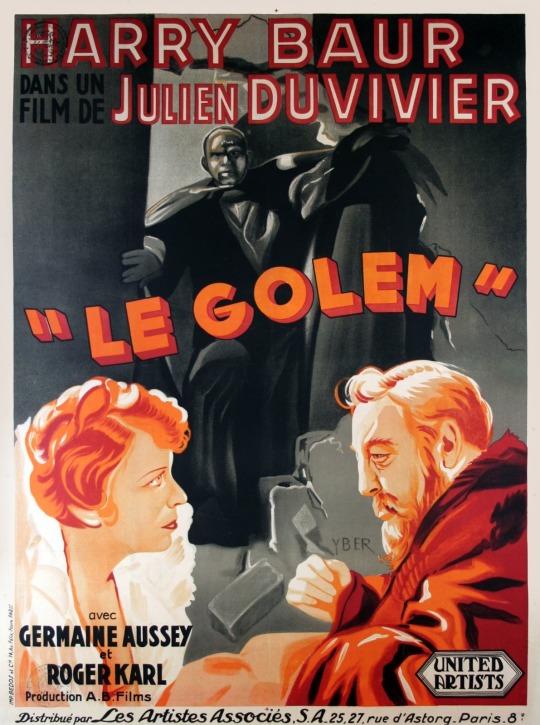
English Title: The Golem
Sequel to: Der Golem, wie er in die Welt kam (1920)
Year: 1936
Genre: Historical Drama, Supernatural Horror
Rating: UR (Recommended: PG-13)
Country: Czechoslovakia
Language: French
Runtime: 1 hour 23 minutes

Director: Julien Duvivier
Cinematographers: Jan Stallic, Václav Vích
Editor: Jiří Slavíček
Composer: Josef Kumok
Writers: André-Paul Antoine, Julien Duvivier, Jiří Voskovec, Jan Werich
Cast: Charles Dorat, Jany Holt, Harry Baur, Roger Karl, Germaine Aussey, Roger Duchense, Ferdinand Hart
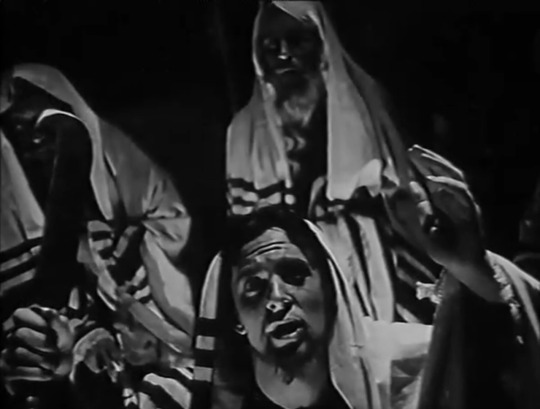
Plot: A rabbi and his wife must reawaken a golem to save their people.
Review: Evocative and progressive for its time, Le Golem paints a painful tale of Jewish persecution and powerful resistance, even if it sometimes focuses too heavily on its villain.
Overall Rating: 3.5/5
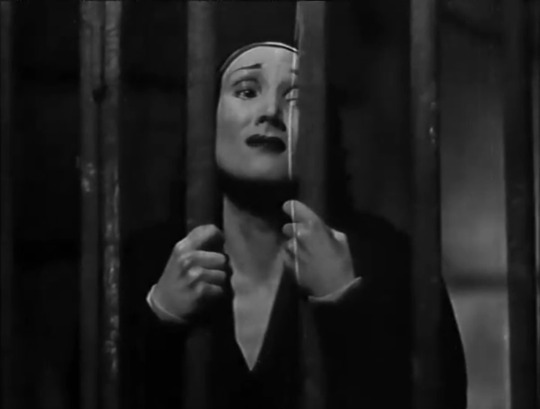
Story: 3.5/5 - (Note: I haven't been able to see the first film, but this can be viewed as a standalone movie.) It expertly highlights individual prejudice and systematic violence, as well as survival in the face of it. Rachel, the rabbi's wife, and Rudolph, the king, are both especially well written, though a bit too much time is spent with the latter.
Performances: 4.5/5 - Everyone is excellent, but Holt is especially compelling as the steadfast Rachel. Baur also does a great job playing a brutal tyrant who is simultaneously deeply pathetic.
Cinematography: 4/5 - Some lovely long distance shots and creative angles.

Editing: 3/5 - A few premature cuts.
Music: 3.5/5
Effects: 3/5 - The destruction the golem unleashes looks solid, though some effects are subpar for the time.
Sets: 4.5/5 - Fantastic, large, and densely populated.
Costumes, Hair, & Make-Up: 3.5/5 - The make-up for Hart's golem is pretty decent and stone-like, and the costuming is quite good.
youtube
Trigger Warnings:
Moderate violence
Torture (brief; not graphic)
Extreme antisemitism (critiqued by the film)
Attempted ethnic cleansing (critiqued by the film)
Gendered violence
#Le Golem (1936)#Le Golem#The Golem (1936)#The Golem#Czechoslovak#Dread by the Decade#review#1930s#make queue vile
5 notes
·
View notes
Photo

1. It’s well known that the earliest gospels do not mention anything about the nativity story. For example, Mark says nothing about it. The birth storyline is known to have been added much later. And even once it is finally added over a century later in Matthew, like every important event in the bible, it’s inconsistent and the different versions are irreconcilable. The birth fable is not regarded as being historically factual.
2. There are no records anywhere of any of the things he supposedly did. There’s no record of the Cleansing of the Temple, which would have been a Jewish scandal, nor any record of thousands of followers going to see him that would necessitate feeding them with a few scraps of food. Nobody literate followed him around and wrote it all down. There are no records of strings of villages where people were mysteriously cured of the most debilitating diseases and maladies untreatable by contemporary medicine, tracing his pathway through the land.
3. The crucifixion fable, aside from being predictably contradictory, is also ahistorical. Crucifixions were not carried out in that way for those purported crimes. Thieves, for example, were not crucified. Those who were crucified were left hanging publicly, to rot and terrify others. The point of crucifixion was not about the punished but the compliance of those who observed the results. Some Jewish rabbi may well have been executed, but the crucifixion described in the bible never happened.
4. The earliest gospels do not mention the resurrection. Mark stops at verse 16:8, and everything after is a known forgery. Even then, this addition spawned multiple conflicting, contradictory tales of the resurrection, which are irreconcilable. Nobody can even actually tell you where the tomb was. The only attestations to it are in gospels written decades after, in propaganda written to recruit believers by people who weren’t there or even alive. The “best” support given for it is that 500 people saw him, without naming a single one of them, where they were, what they saw, how they verified it, and the bizarre claim that believers wouldn’t have insisted it was true, even under duress, unless it was true. As if blind, intractable faith isn’t the cornerstone of Xianity to begin with.
5. The Jesus character was insistent that his return would occur within the lifetime of those he was preaching to. This is stated repeatedly. They are all dead. Even if Jesus had existed, as written in the bible - and we have literally no reason to think so - he must necessarily be regarded as a false prophet. Indeed many of the prophecies Xians claims he fulfils are references to other people, or even other places and things (the “suffering servant” refers to Israel, not an individual), or don’t exist at all.
None of the above is even controversial. And it means it’s impossible for anyone to pretend they know anything about the character.
If you’re a Xian and unaware of this, you should ask yourself why you believe a mythology without knowing the nature of it, and why you just believe what you’re told. If you’re a Xian and are aware of this, you should consider why you still subscribe to a belief that you know to be false.
Time to give it up. The bible’s Jesus character was no more real than Sherlock Holmes.
(And no, a real-world Yeshua, even if you could find him, doesn’t add any weight to the claims of magic and supernatural war in the story.)
#christianity#jesus christ#virgin birth#resurrection myth#resurrection#crucifixion myth#crucifixion#bad fiction#fiction#religion#bible#bible study#blind faith#religion is a mental illness
82 notes
·
View notes
Photo

The Shamir [Jewish mythology]
There is uncertainty over the exact meaning of the word ‘Shamir’ in the Bible and the Targums. It likely refers to an extremely hard substance, of which an excellent stylus can be crafted. It was made after the six days of creation were over, and Moses supposedly used a stylus made from this material to engrave the names of the twelve tribes on the high priest’s breastplate. It’s main purpose, however, was to build the ‘First Temple’ so that no iron or steel tools had to be used. After Solomon accomplished this task, the material lost its supernatural properties.
In Jewish interpretations, the Shamir was a small worm-like creature. This creature did not come into being via natural means, but emerged from powdered corundum. The idea of the Shamir as a rock-eating worm was passed on to Arabic legends. As such, Arab tales tell of Solomon using a Shamir to bore through the middle of a pearl. In the medieval “Gesta Romanorum”, the Roman emperor Diocletianus captured an ostrich and put it in a glass display cage. The ostrich’s mother brought a Shamir worm in her beak, which broke the glass and freed the bird (note that Gesta Romanorum contains stories about Roman emperors, but was fiction written in medieval Europe).
Source:
https://www.jewishencyclopedia.com/articles/13497-shamir
(image source: Eberhard Werner Happel, 17th century, illustration for “Relationes curiosae” vol. 4. The image depicts a fictional stone-eating worm but is often used to refer to the Shamir and over time became the mainstream look of the creature. Image taken from templeofmiriam.com)
85 notes
·
View notes
Text
COMFORT MOVIE CHALLENGE: FANNY AND ALEXANDER
@the-blue-fairie @thealmightyemprex @themousefromfantasyland @angelixgutz @parxsisburning @faintingheroine @princesssarisa @tamisdava2 @goodanswerfoxmonster @amalthea9 @moonbeamelf

Originally released as a television minisseries, director Ingmar Bergman recuted it to fit the format of a feature lenght film, and this version was the one that got nominated and won the Academy Award for best foreign language film, and that is how it ended known internationally.
In Fanny and Alexander, we are taken to 1907 Sweden to see the story of the Ekdahl theater family: the matriarch Helena, her three sons Oskar, Carl and Gustav Adolf, their wives Emilie, Lydia and Eva, Gustav Adolf's and Eva's daughter Petra, Oskar's and Emilie's children Alexander and Fanny, Maj, the young nanny of Alexander and Fanny, and Helena's old friend and lover Isak, who is of jewish origin.
Trough Alexander's eye, we see the Ekdahl house as a place that encourages joy, imagination and freedom: the family is constantly dancing and singing, the children enjoy Alexander's storytelling with use of the Magic Light (one of the oldest versions of the movie camera), Uncle Carl, while alcoholic, abusive in his marriage with the submissive Lydia and full of debts, indulges the children with some toilet humour, Gustav Adolf openly has nanny Maj as his lover with the blessings of his wife Eva, Oskar and Emilie are always bringing the children to the theater world, and Helena rekindles her old flames with Isak.
Sadly for Alexander and Fanny, this atmosphere of freedom and joy is taken from them when their father falls ill while rehearsing the role of the Ghost in Hamlet and dies.
During the funeral, the church bishop Edvard takes advantage of Emilie's emotional vulnerability and seduces her, promissing to be a protector of her and stern moral father figure to the children if she accepts to marry him.
Alexander, who, like his grandmother, is able to see and comunicate with the ghost of his father, sees since the beggining that something is not right with the bishop, but his mother naively dismisses his concerns as jealousy and rebeliousness.
And so, after accepting Edvard's conditions of stoping acting and cutting ties with her old friends, Emilie marries the bishop, taking the children to his grimm house by the coast where he lives with his mother, sister, aunt and housemaids.
Soon, Alexander's predictions about the bishop become true, as his control turns the lives of him, Fanny and his mother a living hell.
Edvard uses his position as a bishop to justify his physical and psychological abuse of the three as being needed to "set them in the right path", specially resenting Alexander's imagination, that he calls "sinful lies".
Meanwhile, the other members of the Ekdahl family, concerned for the well being of Emilie and the children, try to prepare a plan with Isak to rescue them and bring them back to the safety of their home once and for all.
Being a movie that focuses on how an imaginative child that comes from an artistic family sees the world, you can describe the film as a modern fairy tale, with the focus on the domestic family drama seen under big proportions, a clear cut conflict of good and evil represented by the Ekdahl family against the bishop stepfather, the desire of return to the old home and family unity being the main desires of the main characters, and the presence of the supernatural with Alexander and Helena's vision of Oskar's ghost treated by them as a natural thing, rather than being a subject of scientific debate.
Due to being a former minisseries, some scenes may feel that lack proper context and explanation due to the difference in cuts, but the artfull editing that makes even the scenery become a character and the fact that the story focuses on a child's dream rather than naturalist realism may very well compensate for the detriment of these extra explanation dialogues.
The movie is primarily a celebration of idealism and imagination that helps us move on with life after suffering harsh traumatic events, well represented by this speech sayed by the character of Gustav Adolf to celebrate his family's connection to the world of the theater:
"Therefore let us be happy while we are happy. Let us be kind, generous, affectionate and good. It is necessary and not at all shameful to take pleasure in the little world."
And I recomend watch this movie at least once in your life. Its an experience that asks for sensitivity and concentration, so when you are alone, open your mind to this child's little world.
16 notes
·
View notes
Text
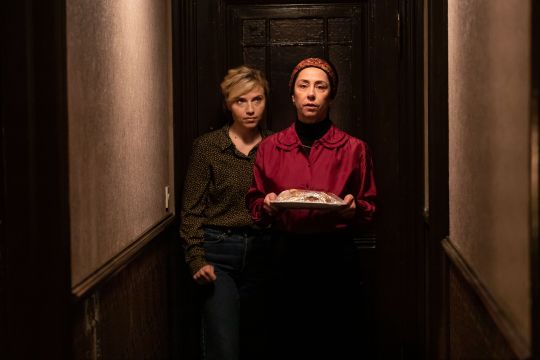


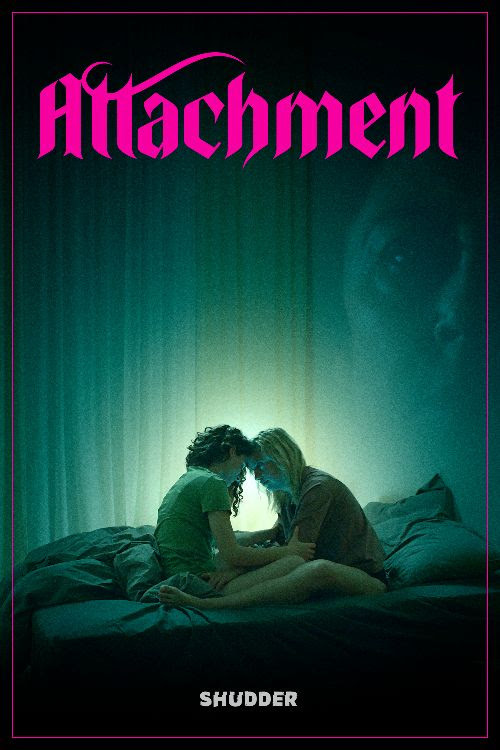
Gabriel Bier Gislason’s feature debut is both a cross-cultural queer love story and a tale of demonic (dybbuk) possession that sources its mythology from Jewish folklore.
While the possession and exorcism sub-genre of horror may be incredibly oversaturated by the exploits of Catholic priests, by sourcing its demonic possession mythology from Jewish folklore, Gabriel Bier Gislason’s debut feature ATTACHMENT breathes new life into the staple of supernatural horror. Written for lead actress Josephine Park, and loosely inspired by tales of her life, ATTACHMENT is also a complex and nuanced love story between two women of vastly different cultural backgrounds.
12 notes
·
View notes
Text

A lot of Genshin Impact's lore takes inspiration from the Kabbalah and Judaism as a whole. This video does some explaining on what a descender, one who practices Merkava, is in Jewish mysticism. Something I find interesting is the tale of the four descenders, one version of which you can read here. Its parallels to Genshin (which might I remind you means "ascended") are interesting in that it, too, has four descenders, and has some parallels to Before Sun and Moon.
The Talmud warns that among four men who engaged in Merkava, one died, one went mad, one apostatized, and only Rabbi Akiba ben Joseph had a true visionary experience. Those who practiced Merkava were sometimes called Explorers of the Supernatural World (Yorde Merkava) -Britannica
Note: Please treat the religions from which Genshin takes its inspiration with utmost respect. Genshin Impact is fantasy, but this isn't.
2 notes
·
View notes
Text
"When Franny Stands Up," Eden Robins' debut novel
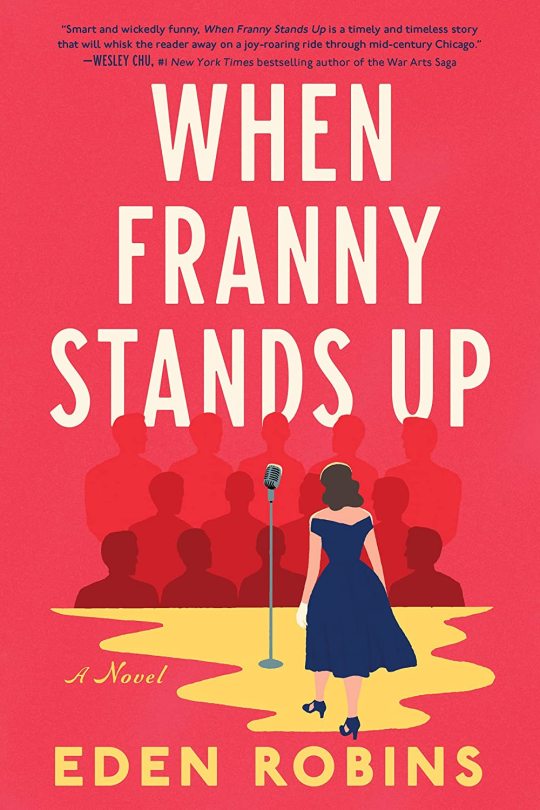
Of all the alternate history premises in fiction, the McGuffin of Eden Robins’s debut, “When Franny Stands Up,” is one of the most unlikely and — it turns out — rich. Robins’ novel opens on Franny, a teenage Jewish girl from the Chicago suburbs who’s snuck out on Christmas Eve to hear the notorious comedian Boopsie Baxter do standup.
https://read.sourcebooks.com/fiction/9781728256009-when-franny-stands-up-tp.html
It’s an all-female audience. After all, WWII is in full swing, and all the young men are Over There, including Leon, the older brother Franny adores. But there’s another reason that Boopsie can pack the house with women: she’s got a Showstopper.
This is the alternate history part. In Robins’ world, the advent of World War II and the rise of woman comedians (filling in the vacuum left by the departure of all the men) reveals the existence of Showstoppers: involuntary psychic reactions that woman comedians can induce in female audience members when they’re really cooking.
Some Showstoppers are relatively mild — like the uncanny sensation that you have just caught your bus. Boopsie Baxter’s is a little more intense: she induces involuntary, powerful orgasms in the women who hear her sets. So yeah, she’s got a packed house.
The magazines where Franny learned about Boopsie are squeamish about this, speaking in ellipses and euphemisms of Boopsie’s Showstopper, and Frannie (young, naive) doesn’t understand what’s happening when Boopsie works her magic. Panicked and ashamed, she runs out of the room and flees home — just in time to learn that her brother Leon is missing in Belgium, lost in battle and presumed dead.
That’s the setup. When we return to the action seven years later, Leon is home — shell-shocked and traumatized — and the world is roaring into the post-war new normal. Franny gets roped into sneaking out to a show at the Blue Moon, Chicago’s last all-female showcase for comedians and their Showstoppers.
And that’s where the action really takes off. Franny, it turns out, is funny. She’s also pretty messed up. And soon enough, she’s involved with the gangster’s wife who runs the Blue Moon, and the comedians in her stable, and there’s the clean-cut young man across the street who sexually assaulted her on her 21st birthday and the blockbusting Black family who lives next door to him but might as well be on the moon for all the neighbors interact with them.
On one level, this is a period coming-of-age piece about Franny, who is trying to release the humor that comes from the pain in her life and the lives around her — and reveal her Showstopper, and maybe save the Blue Moon from being shut down by the gangster who owns it.
On another level, this is an utterly contemporary story about allyship, gender and sexuality, one that never introduces an anachronism even as it explores how these eternal themes played out in a very different time and place.
It’s a book about comedy, so it’s funny — but it’s a book about comedy, so it’s also wrenching and difficult to look at (or look away from) in places. The supernatural conceit at the heart of the tale — the Showstoppers — are played perfectly, in matter-of-fact realness, and the rules that say men can’t experience or create Showstoppers creates perfect cover for how something so profound could be confined to such a small corner of the world.
I taught Robins at the Clarion West workshop more than a decade ago. Even then, she was a standout for her slick prose, deft characterizations, and humor. Now, an overnight sensation more than a decade in the making, that promise has blossomed into an outstanding talent, a storyteller who manages to tell tales that feel utterly contemporary and like old classics.
13 notes
·
View notes
Text
Epic Fantasy through the Ages
A Chronology of Story
This is a work in progress, but here is my list as of 6 July 2023. Please feel free to send me additions or corrections. I have focused on epic (works that are long and took a long time to create) and fantasy (works that include an element of magic, the supernatural, or superpowers). Some of the list could be categorized as myth, some as Literature™️, some as science fiction, but beyond these categories are the two main criteria of epic and fantasy. I also don't fully know what all of the ancient to modern works encompass, but that's the fun of read and find out. I probably have added some things that don't properly meet my criteria, and that's fine with me. 🌺
Works by Mesopotamian Bards (3100 BC - 539 BC)
Enumah Elish (Epic of Creation)
Atrahasis (The Flood)
Epic of Gilgamesh
Descent of Ishtar
Epic of Erra
Etana
Adapa
Anzu
Nergel and Ereshkigal
Avesta by Zoroastrian Bards (1500 BC)
Ramayana by Valmiki (750+ BC)
Mahabharata by Vayasa (750+ BC)
The Illiad and the Odyssey by Homer (650+ BC)
Thoegeny; Works and Days by Hesiod (650+ BC)
Popol Vuh (4th century BC)
The Torah and other Jewish stories (4th century BC)
Argonautica by Apollonius of Rhodes (270 BC)
Bellum Punicam by Gnaeus Naevius (200 BC)
Annales by Ennius (170 BC)
De Rerum Natura by Lucretius (50 BC)
Poem 64 by Catullus (50 BC)
The Aenid by Virgil (19 BC)
Metamorphoses by Ovid (2 AD)
Punica by Silius Italicus (50 AD)
Satyrica by Petronius (60 AD)
Pharsalia or Bellum Civile by Lucan (62 AD)
Argonautica by Valerius Flaccus (70 AD)
Thebaid by Statius (90 AD)
The Irish Myth Cycles: Mythological, Ulster, Fenian, and Kings (3rd Century AD)
The Bible and other Christian stories (5th century AD)
Dionysiaca by Nonnus of Panopolis (500 AD)
The Quran and other Muslim stories (7th century AD)
Arabian Nights (7th century AD)
Hildebrandslied and other German heroic lays by Bards (830 AD)
Shahnameh by Ferdowsi (977 or 1010 AD)
Chanson de Roland (1125 AD)
Cantar de Mio Sid (1200 AD)
The Dietrich Cycle (1230 AD)
Poetic Edda and Prose Edda by Snorri Sturluson and others (1270 AD)
Beowulf by Old English Bards (11th century AD)
Nibelungenlied by Middle High German Bards (1200)
Amadís de Gaula (13th century AD)
The Divine Comedy by Dante Alghieri (1308)
Teseida by Bocaccio (1340 AD)
Sir Gawain and the Green Knight by Middle English Bards (14th century)
The Canterbury Tales by Geoffrey Chaucer (1392)
Morgante by Luigi Pulci (1483)
Le morte d'Arthur by Thomas Mallory (1485)
Orlando Innamorato by Boiardo (1495)
Orlando Furioso by Ariosto (1516)
Os Lusiadas by Camoes (1572)
Gerusalemme Liberata by Tasso (1581)
Plays and Poems by William Shakespeare (1589)
The Faerie Queen by Edmund Spencer (1590)
Discourses on the Heroic Poem by Tasso (1594)
Don Quixote by Miguel de Cervantes (1614)
L'Adone by Marino (1623)
Paradise Lost; Paradise Regained by Milton (1667)
Le Lutrin by Boileau (1674)
Order and Disorder by Lucy Hutchinson (1679)
Mac Flecknoe; Aenid English translation by Dryden (1682)
The Dispensary bu Samuel Garth (1699)
The Battle of the Books; A Tale of a Tub by Swift (1704)
The Rape of the Lock; Illiad and Odyssey English translations; Dunciad by Pope (1714)
The Vanity of Human Wishes by Samuel Johnson (1749)
Scribleriad by Richard Owen Cambridge (1751)
Faust by Goethe (1772)
The Triumphs of Temper; Essay on Epic Poetry by William Hayley (1782)
The Task by William Cowper (1785)
Joan of Arc; Thalaba the Destroyer; Madoc; The Curse of Kehama by Southey (1796)
The Prelude; The Execution by Wordsworth (1799)
Jerusalem by Blake (1804)
The Rime of the Ancient Mariner by Coleridge (1817)
Laon and Cythna; Peter Bell the Third; Prometheus Unbound by Shelley (1817)
Hyperion: A Fragment; The Fall of Hyperion by Keats (1818)
Don Juan by Byron (1819)
The Kalevala by Elias Lonnrot (1835)
Sohrah and Rustum by Matthew Arnold (1853)
Hiawatha by Longfellow (1855)
Leaves of Grass by Walt Whitman (1855)
Idylls of the King by Lord Alfred Tennyson (1859)
Cantos by Ezra Pound (1917)
The Wasteland by T.S. Eliot (1922)
Ulysses by James Joyce (1922)
The Hobbit/The Lord of the Rings/The Silmarillion etc. by J.R.R. Tolkien (1937)
Gormenghast by Mervyn Peake (1946)
The White Goddess by Robert Graves (1948)
Hero with a Thousand Faces by Joseph Campbell (1949)
The Chronicles of Narnia by C.S. Lewis (1950)
Anathemata by David Jones (1952)
Dune by Frank Herbert (1965)
The Dark Is Rising Sequence by Susan Cooper (1965)
Briggflatts by Basil Bunting (1965)
Earthsea by Ursula K. LeGuin (1968)
Dragonriders of Pern by Anne McCaffrey (1968)
The Chronicles of Amber by Roger Zelazny (1970)
The Vampire Chronicles by Anne Rice (1976)
The Chronicles of Thomas Covenant by Stephen Donaldson (1977)
The Magic of Xanth by Piers Anthony (1977)
Book of the New Sun by Gene Wolf (1980)
The Dark Tower by Stephen King (1982)
Belgariad and Mellorean by David Eddings (1982)
The Mists of Avalon by Marion Zimmer Bradley (1982)
Shannara by Terry Brooks (1982)
The Riftwar Cycle by Raymond E. Feist (1982)
Discworld by Terry Pratchett (1983)
Mythago Wood by Robert Holdstock (1984)
Neuromancer by William Gibson (1984)
The Black Company (1984)
Redwall by Brian Jaques (1986)
Valdemar by Mercedes Lackey (1987)
Memory, Sorrow, Thorn by Tad Williams (1988)
Sandman by Neil Gaimon (1989)
The Wheel of Time by Robert Jordan (1990)
Queen of Angels by Greg Bear (1990)
Newford by Charles de Lint (1990)
Omeros by Derek Walcott (1990)
The Saga of Recluse by L.E. Modesitt, Jr. (1991)
The Witcher by Andrzej Sapkowski (1993)
Sword of Truth by Terry Goodkind (1994)
Realm of the Elderlings by Robin Hobb (1995)
His Dark Materials by Philip Pullman (1995)
Old Kingdom by Garth Nix (1995)
A Song of Ice and Fire/Game of Thrones by George R.R. Martin (1996)
Animorphs by H.A. Applegate (1996)
Crown of Stars by Kate Elliott (1997)
Harry Potter by J.K. Rowling (1997)
The Malazan Book of the Fallen by Steve Erickson (1999)
The Dresden Files by Jim Butcher (2000)
The Inheritance Cycle by Christopher Paolini (2002)
Prince of Nothing by R. Scott Bakker (2003)
Bartimaeus by Jonathan Stroud (2003)
The Gentlemen Bastard Sequence by Scott Lynch (2004)
Twilight by Stephanie Meyer (2005)
Percy Jackson and the Olympians by Rick Riordan (2005)
Temeraire by Naomi Novik (2006)
The First Law by Joe Abercrombie (2006)
Mistborn by Brandon Sanderson (2006)
The Kingkiller Chronicle by Patrick Rothfuss (2007)
Shadows of the Apt by Adrian Tchaikovsky (2008)
The Hunger Games by Suzanne Collins (2008)
Graceling by Kristin Cashore (2008)
Riyria Revelations by Michael J. Sullivan (2008)
Night Angel by Brent Weeks (2008)
The Demon Cycle by Peter V. Brett (2008)
Inheritance by N.K. Jemisin (2010)
The Lightbringer by Brent Weeks (2010)
The Stormlight Archive by Brandon Sanderson (2010)
The Expanse by James S.A. Corey (2011)
The Broken Empire by Mark Lawrence (2011)
The Lunar Chronicles by Marissa Meyer (2012)
Throne of Glass by Sarah J. Maas (2012)
Grishaverse by Leigh Bardugo (2012)
The Traitor Son Cycle by Miles Cameron (2012)
Worm by Wildbow (2013)
The Powder Mage by Brian McClellan (2013)
The Broken Earth by N.K. Jemisin (2015)
Shards of Heaven by Michael Livingston (2015)
The Green Bone Saga by Fonda Lee (2017)
The Band Series by Nicholas Eames (2017)
Winternight by Katherine Arden (2017)
The Folk of the Air by Holly Black (2018)
The Founders by Robert Jackson Bennett (2018)
The Locked Tomb by Tamsyn Muir (2019)
Grave of Empires by Sam Sykes (2019)
Djeliya by Juni Ba (2021)
6 notes
·
View notes
Text
BLOOD RELATIVES: A Heartfelt, Hilarious, and Bloody Character Study

Blood Relatives--written, directed by, and starring Noah Segan--is one of the most entertaining films I have seen all year. This is the kind of movie I am always on the lookout for. It's charming, unique, and heartfelt--while still firmly fitting into the horror genre.
Blood Relatives follows Francis (Noah Segan)--a Yiddish vampire who has been traveling the backroads of American alone--until he meets Jane (Victoria Moroles), his daughter. He must decide if he can change his ways and be a true father for Jane--while also helping her to handle her vampire tendencies.
Heartfelt Horror
It takes so much skill to create something that is both wholly unique and wears its influences on its sleeve--loud and proud. Blood Relatives is a film that truly sings as a perfect amalgamation of Paper Moon with vampires and Jewish culture.
This combination is something I never expected, but it works so well together. Segan's script finds the humanity and humor in its supernatural characters--exploring relatable moments between this father and daughter duo that are also wholly connected to their uniquely vampire problems.

Blood Relatives is a beautiful coming-of-age story--centered around Jane learning why she has a penchant for rare burgers. Jane is on a journey to discover how to be a vampire and a teenage girl.
The unlikely duo of Jane and Francis leads to some delightful comedic moments and wonderful performances from Noah Segan and Victoria Moroles--highlighting the differences and similarities between this father and daughter pair.
Strong Story and Performances
For Francis, it's difficult to accept that his life is forever changing, and much like Paper Moon, the film thrives when the worlds of 'vampire' and 'dad' are the most connected. Some of the funniest--and most heartfelt-- moments in Blood Relatives tell familiar coming-of-age stories with the twist of their peculiar, bloody affliction.
Segan's decision to write his lead character as a Jewish vampire is delightful--and the best part: this aspect of the character is completely felt throughout the entire film and Segan's performance captures the heart of Francis and is a beautiful depiction of the journey one takes into fatherhood.

Combining horror with other genres can be tricky--and what makes Blood Relatives so good is how present those other genres are within this memorable film. Blood Relatives is a coming-of-age film and a character study of its two complex, extremely well-developed characters--showing how both Francis and Jane grow throughout their road trip.
Blood Relatives is heartwarming and relatable, as well as being hilarious. The comedy works so well, especially when it comes from classic Vampire lore and how Francis and Jane fit in with these established tropes.
Noah Segan and Victoria Moroles bring the already funny material up a notch with their performances. Segan's inflection and movements create a wonderful, funny dissonance with the typical brooding vampire.

Francis might wear the leather jacket, but his personality is more of a goofy, lovable dad--even before meeting Jane. And this makes the early moments in the film such a delight to watch.
Francis is a lone wolf, but one closer to Lenny Kosnowski. And that makes Francis such a wonderful character and Noah Segan's performance so good, capturing the character's personality that is equally distant, cool vampire, and dad who thinks he's a distant and cool vampire.
Victoria Moroles gives a great performance as Jane, and the moments where she is working through her recently discovered vampire traits and bonding with her newfound dad.
Beautiful, Striking Cinematography
As well as being a cute, heartfelt tale of family--and finding where we belong, no matter how much we feel we don't quite fit in--Blood Relatives also boasts striking cinematography.
The cinematography of Blood Relatives perfectly captures the beauty of small towns, road trips, and the unfamiliar--secluded roads, seedy bars, the fog coming off bright, neon lights.

Throughout most of the film, the nighttime is lit up with a pulsating energy. The cinematography reflects the film and the journey of its protagonists. In one moment--where the future of Jane and Francis' unconventional family is up in the air--the film takes on a dim, faded appearance.
But once Jane leans into her vampire tendencies, the color starts to become more vivid--highlighting the beauty of the sunset and the world at night.
Conclusion
Noah Segan's debut as writer/director offers a unique, heartfelt and hilarious take on classic vampire lore and the journey of fatherhood. Noah Segan and Victoria Moroles shine as the unlikely father and daughter duo.
Blood Relatives is a Shudder/AMC + Original and was released November 22nd on both platforms.
8 notes
·
View notes
Text
BLOGTOBER 10/6/2022 - GOLEMANIA! PT 1: DER GOLEM - HOW HE CAME INTO THE WORLD
For Blogtober 10/6 and 10/7, I examined two films about Jewish mysticism, both made by non-Jews, both long unavailable (or simply not available enough), and both fine examples of the style and visual capabilities of their times.
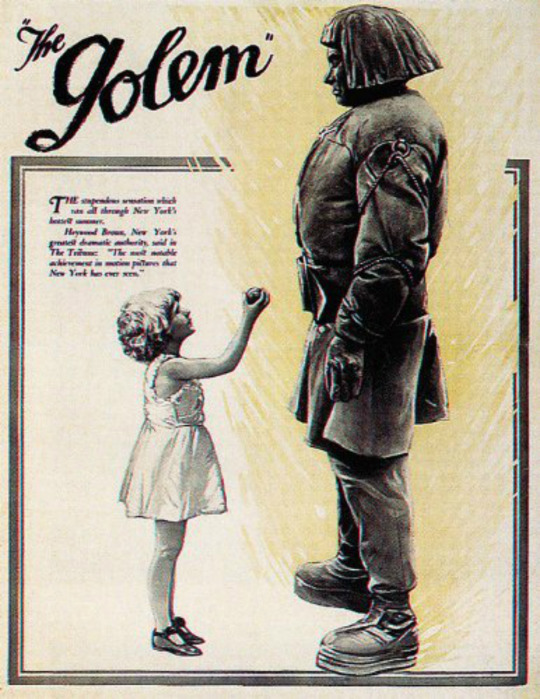
Though THE GOLEM: HOW HE CAME INTO THE WORLD represents an important beat in the development of German expressionist cinema, and any self-respecting nerd has seen plenty of beguiling stills from it, not as many people know it well enough to discuss it on the level that NOSFERATU or THE CABINET OF DR. CALIGARI enjoy. This is surely relatable to availability issues—in fact, the film is part of a trilogy, along with 1915's THE GOLEM and the 1917's THE GOLEM AND THE DANCING GIRL (apparently a primordial example of a horror-comedy!), but these other two are lost to time. The 1920 release, which I'll call DER GOLEM for convenience's sake, is the result of director and star Paul Wegener's desire to update his first effort, which was compromised by a number of disappointing production problems. So, it seems that if we can only have one of his Golem movies, it may as well be this one.
DER GOLEM is the collaboration of writer-director Wegener, his co-writer Henrik Galeen (see also: NOSFERATU), and his co-director Carl Boese, who I assume was especially necessary as Wegener himself plays the title role. The film is adapted from a novel by Austrian author Gustav Myer, which is further based on a Jewish folk tale, and it is interesting to see how this Germanic creative team express their impressions of the history of Jewish persecution. Some critics have found antisemitic underpinnings in the film, largely due to the (delightfully) frightening depiction of the esoteric practice that activates the Golem (which may have a deeper meaning than is immediately apparent), but that would be throwing the baby out with the bathwater. Despite the film being rather brief and broad, it is full of complex, sympathetic characters who transform significantly as the narrative unspools.
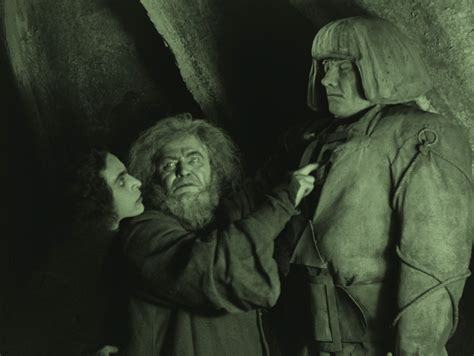
The story takes place in the Jewish ghetto of medieval Prague, where the venerable Rabbi Loew (Albert Steinrück) reads a warning in the stars predicting an imminent danger to his people. Sure enough, an edict comes down from the Holy Roman Emperor (Otto Gebühr) condemning the Jews for their evil character, and ordering their expulsion from the region. Loew creates a hulking clay protector who is brought to life by a sacred word hidden in a star-shaped talisman lodged in his chest, and thinks to impress and entertain the Emperor with his abilities in order to ameliorate the situation. The Golem makes a big splash in the Emperor's court, but the Rabbi's other demonstration doesn't go so well; he implores his audience not to laugh or speak during a magical cinematic projection of the history of the Jewish people, but they can't contain themselves, and the palace begins to crumble. When they are saved by the Golem, the Emperor gratefully rescinds his edict.
Now, this may be enormously crass of me, but I really, deeply think it would be incredibly great if Alamo Drafthouse made one of their pre-show warnings out of this scene. DON'T TALK. DON'T TEXT. OR THE GOLEM WON'T SAVE YOU FROM THE SUPERNATURAL DESTRUCTION OF YOUR EMPIRE.

The other thing I'd like to casually note about this first section, just because it's something I happen to know a little bit about, is that Rabbi Loew's invocation of the goetic demon Astaroth is not really equatable with the idea of devil worship that some viewers have extracted from this—which is fair, because this isn't easy to understand, nor is it readily accessible information. But (and I'm speaking very colloquially here) Astaroth is said to have mastery over esoteric knowledge, and one would work with him in order to gain more occult (for lack of a better word) enlightenment; so, it makes sense that he gives Rabbi Loew the sacred animating word. The other thing about working with demons is that they represent some set of what are usually considered to be negative characteristics: say, slander, wrath, vengeance, etc. So you might work with one of them to deflect these archetypal energies if they are directed at you by someone else. But, you'll also want to be prepared to address these elements in a mature and intelligent way, lest you be overtaken by them yourself. The final effect would be that you've learned an important lesson, and can't be harmed or dominated by whatever malefic characteristic you're dealing with.
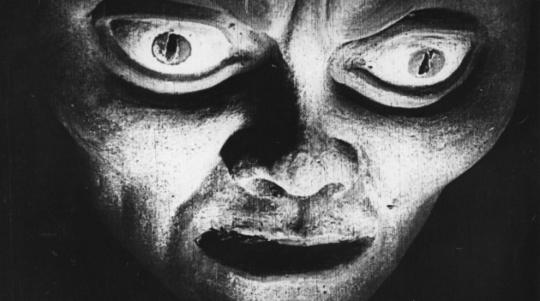
Once the Golem has served its purpose in averting the persecution of the Jews, Loew receives a warning that Astaroth may take it over and use it for vengeful violence. Loew wisely deactivates the creature, but while he goes out to join in communal celebrations, his Assistant makes a big mistake. (The Assistant is played by Ernst Deutsch, a Jewish actor and athlete who I just saw a couple days ago in ISLE OF THE DEAD! I didn't make a note of his wonderful performance as the gently cynical doctor in that film, and now I'm sorry about it) He has fallen in love with the Rabbi's daughter Miriam, and is appalled when he discovers her affair with the Emperor's arrogant squire Florian (Lothar Müthel). The Assistant sets the Golem on Florian, but of course the situation spins out of control, forcing Rabbi Loew to save the community once again.
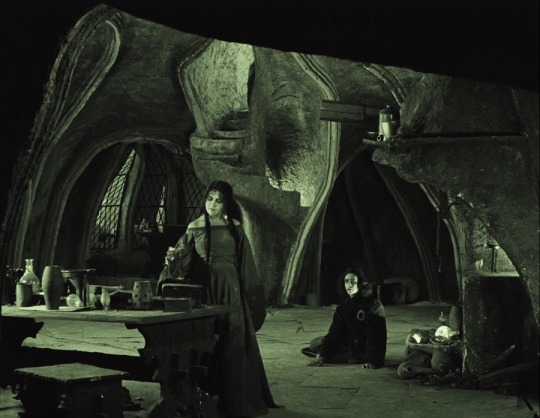
The Golem is an obvious ancestor of Frankenstein's monster, and his misadventure is startlingly similar to that of the better-known creature. Paul Wegener's expressive performance evokes the same range of anger, fear, and naive desire, and his moving interaction with an innocent child is abundantly familiar. In general, DER GOLEM is competitive with FRANKENSTEIN in its emotional complexity; even its villains are tragically human, driven at first by selfish compulsions, but faced with the consequences of their actions, they are sincerely penitent. Even the basics of antisemitism are addressed handily in the film, as the Jews' spartan existence in the ghetto, where their greatest treasures are their traditions and sense of community, flies in the face of the Emperor's accusation that they are avaricious and materialistic. (This coming down from a man bedecked in finery sitting on a gleaming throne, naturally)
The principle gift of DER GOLEM is its advanced aesthetics, owing to the fine work of master cinematographer Karl Freund and architect Hans Poelzig. But the film is bigger than its contributions to film history, telling a sensitive tale that is still surprising in its depth and thoughtfulness. I was glad to see there are new blu ray releases of the film from the last few years, and I'm excited to get my hands on one.

#blogtober#blogtober 2022#golemania#the golem: how he came into the world#der golem: wie er in die Welt kam#paul wegener#carl boese#karl freund#henrik galeen#gustav myer#Albert Steinrück#Otto Gebühr#Ernst Deutsch#Lyda Salmonova#horror#folk horror#german expressionism#hans poelzig#supernatural#occult#esoterism#frankenstein#religion
8 notes
·
View notes
Text
spinning silver, by naomi novik: three and four fifths coins out of five
a young jewish woman takes charge of her father's moneylending business and soon brags that she can turn silver into gold (to say nothing of the pennies she started with!). her entanglements, both with a local gentile family and with a supernatural element, soon complicate the story.
spinning silver is a welcome look at what might have been happening for jewish characters during the fairy tale era. like with uprooted, novik is drawing from her own family heritage here. much of the novel focuses on relationships with gentiles, some of whom are also central characters. like uprooted, there is a bit of hopscotch plotting -- hopping from one arc to the next rather than having a single long plot arc for the book -- but there is more continuity in this story, as the problem of the protagonist's brag carries through most of the book and the other problems are woven into that. there are a lot of "they'll never get out of this one!" predicaments, although since this is a fairy tale you can guess how it ends (note: some fairy tales do end with everyone dying). slightly strange that a very cold romance ends up resolving with a marriage.
a vastly unsubtle reminder that bragging can get you in trouble. also a suggestion that, if you can back the brag up, you still might stand to win. it's a solid book, but it didn't enrapture me enough to rate a full four stars.
#naomi novik#spinning silver#fantasy#fairy tales#book reviews#book review#reviews#review#jewish characters
6 notes
·
View notes